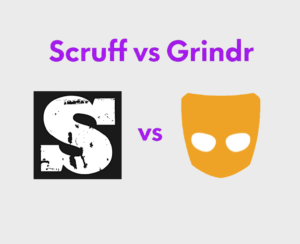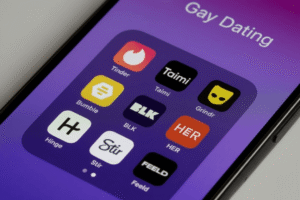
At a glance, Tinder and Grindr might look similar – both are swipe-based apps designed to help people meet. But once you look closer, it becomes clear that they serve very different audiences and are used for different purposes.
Tinder is a mainstream dating app with a wide user base. It’s used mostly by straight men and women, though it supports multiple gender preferences. People use it for everything from casual hookups to serious relationships.
Grindr, on the other hand, is built specifically for gay, bi, and curious men. Often called “the gay Tinder,” it focuses more on quick, location-based connections and is widely associated with casual encounters, though people also use it for dating and friendships.
Grindr or Tinder: Which Is Right for You?
Before choosing one, it helps to understand how they work and what kinds of connections they are best for. This article breaks down the key differences so you can decide which app fits your needs.
Audience and Purpose
Tinder is a broad, mainstream dating app that appeals to a wide range of users, including heterosexual, bisexual, and LGBTQ+ individuals. It is used for various purposes, from casual dating and hookups to serious relationships and social discovery. Its versatility makes it popular across age groups and locations, attracting millions of users looking for different types of connections.
Grindr is designed primarily for gay, bisexual, transgender, and queer men (GBQT). While it can also be used to form friendships and community connections, the app is heavily focused on meeting men for casual encounters or dating. Its specialized audience makes it the go-to app for many in the LGBTQ+ community seeking men specifically.
Profile Structure and Identity
Tinder uses a full-profile model that allows users to showcase themselves through multiple photos, a bio, and optional fields like job, education, and Instagram or Spotify integration. Users can specify their gender and sexual orientation, which helps match them with compatible people. Profiles encourage storytelling and longer-term matching signals, allowing users to get a better sense of potential connections before starting a conversation.
Grindr’s profiles are compact and concise. Each profile typically includes a photo, a short tagline, age, location, and optional fields such as “tribe,” relationship status, “about,” and HIV status. The app emphasizes quick identity signals that are most relevant to GBQT users, allowing people to scan profiles quickly and decide whether to engage. Profiles are designed for efficiency rather than detailed narratives.
Discovery and Matching Mechanics
Tinder relies on a swipe-based mutual opt-in system. Users swipe right to like a profile and left to pass; when two people swipe right on each other, a match occurs, and a chat opens. Tinder uses global algorithms – such as Elo-style ranking or engagement signals – to surface profiles that are likely to match your preferences. This creates a curated experience that balances location, activity, and profile attractiveness.
Grindr uses a grid-based real-time browsing system sorted by proximity. Users can see nearby profiles and message almost anyone immediately without requiring a mutual match, though options to block or report users exist. The interaction is highly location-driven, and the immediacy encourages fast, direct communication. Users often discover potential connections based on who is currently online and nearby.
Privacy and Visibility
On Tinder, matches are private; contact is only revealed when both users like each other. While the app uses location to find matches, it does not display precise coordinates. Paid features like Tinder Plus, Gold, or Platinum offer the “Passport” feature, allowing users to change their location and explore connections in different cities.
Grindr prominently shows approximate distances to other users and organizes them in a nearby grid. Location visibility is more apparent, which can be convenient but also raises privacy considerations. Premium features like Grindr XTRA or Unlimited provide options such as incognito mode and location blurring to increase user control over visibility.
Safety and Moderation
Tinder has implemented moderation and reporting tools, photo verification, and safety features such as panic buttons in some regions. Given its large, general audience, its moderation system is designed to handle a broad range of issues, from harassment to fake profiles.
Grindr also provides reporting, blocking, and safety features. Historically, it has faced privacy concerns, particularly regarding sensitive profile fields like HIV status. The app has introduced improvements to address these issues, but the nature of Grindr’s proximity-based features means privacy remains a sensitive topic for many users.
Conversation Dynamics and Norms
On Tinder, conversations generally start after a mutual match. The tone and pace can vary, ranging from long-term dating discussions to casual chats. Interactions are often slower and more profile-driven, giving users time to read bios and evaluate compatibility before messaging.
On Grindr, conversations often start immediately with nearby users. The tone tends to be direct and pragmatic, frequently oriented toward arranging meetups. Communication norms vary depending on the city or subcommunity, but speed and immediacy are common characteristics of Grindr interactions.
Monetization and Features
Tinder uses a freemium model. Free users can swipe and match, while paid subscriptions such as Tinder Plus, Gold, or Platinum provide boosts, super likes, and algorithmic enhancements to increase profile visibility and access additional features.
Grindr also operates on a freemium model. Premium subscriptions like Grindr XTRA or Unlimited unlock advanced filters, greater profile visibility, an ad-free experience, and other perks designed to improve discovery and connection.
Typical Use-Cases
Tinder is often used to meet people across sexual orientations for dating, relationships, or casual encounters. Its focus on curated profiles and mutual opt-in matches makes it suitable for both short-term and long-term interactions.
Grindr is ideal for quickly finding nearby GBQT men for hookups, friendships, or community interaction. Its emphasis on immediacy and proximity caters to users who want fast, direct connections rather than long-term matchmaking.
Grindr vs Tinder: Which One Is Better for You?
So, which dating app should you choose? The answer depends entirely on your goals.
Choose Grindr if: You are a gay, bisexual, trans, or queer man looking for fast, location-based connections. Grindr is the best option for hookups and is ideal for quickly meeting nearby guys for anything from a casual chat to a spontaneous meetup.
Choose Tinder if: You’re looking for a broader dating experience and are open to anything from hookups to serious relationships. Tinder’s diverse user base and profile-focused design help you connect over shared interests, making it a versatile choice for almost anyone.
While both apps are popular with millennials and have a male-dominated user base, Tinder generally has a larger population of female users.
You don’t have to commit to just one. The best way to find your perfect match is to try the app that fits your current needs and see who you meet.
Happy dating!
Ready to Find Your Special Someone?
Join our LGBTQ community and connect with like-minded people for relationships or hookups.
Create Your Profile Now

